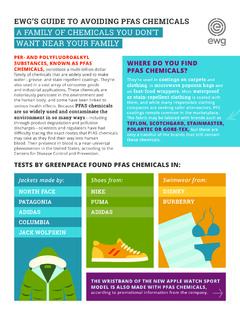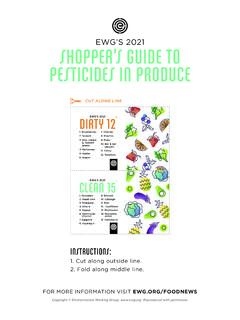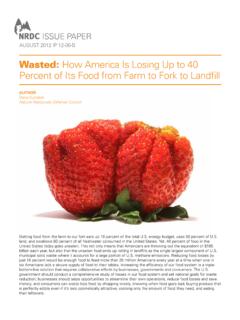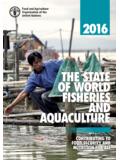Transcription of LIFECYCLE ASSESMENTS: METHODOLOGY & RESULTS
1 LIFECYCLE ASSESMENTS: METHODOLOGY & RESULTS . Meat Eaters Guide: METHODOLOGY Table of Contents Acknowledgements.. 4. Introduction.. 5. A. LCA Boundaries and Functional Unit .. 5. B. Apportionment of GHGs to food versus non-food products (co-product allocation).. 7. C. Modeling Agricultural Processes: Data and Emissions Factors.. 7. 1. Key Inputs and Emission Outputs.. 7. 2. Activity Data and Criteria for Selection of Production Systems.. 9. 3. Data Sources for Calculating Emissions from Each Stage of Production.. 10. 4. Model Testing, Validation, Uncertainty and Variability.. 17. D. Modeling Emissions from Meat, Dairy and Egg Production and Consumption.. 21. 1. Beef Production.. 24. 2. Lamb Production.
2 27. 3. Pork Production.. 29. 4. Poultry (Broiler Chicken and Turkey).. 30. 5. Dairy (Cheese) .. 33. 6. Eggs .. 36. 7. Farmed Salmon.. 37. 8. Canned Tuna.. 38. E. Modeling Emissions from Feedstock and Crop Production.. 40. 1. General Production and Modeling Details.. 40. 2. Specific Modeling Details for Feedstock Production.. 40. a. Corn Production.. 40. b. Soybean Production .. 41. c. Alfalfa Production.. 43. d. Lentil Production.. 44. 3. Sources of Emissions of Plant Protein .. 47. 2 Environmental Working Group Meat Eaters Guide: METHODOLOGY 2011. Tables Table 1. Sources of Primary Greenhouse Gas Emissions .. 8. Table 2. Validation of EWG LCA GHG Emission RESULTS of Protein-Rich Foods.. 19. Table 3.
3 LCA Allocation Factors.. 22. Table 4. GHG Emissions from Beef Production (at farmgate).. 25. Table 5. GHG Emissions from Beef Consumption (post-farmgate).. 25. Table 6. GHG Emissions from Lamb Production (at farmgate).. 28. Table 7. GHG Emissions from Lamb Consumption (post-farmgate).. 28. Table 8. GHG Emissions from Pork Production (at farmgate).. 29. Table 9. GHG Emissions from Pork Consumption (post-farmgate).. 30. Table 10. GHG Emissions from Broiler Chicken Production (at farmgate).. 31. Table 11. GHG Emissions from Broiler Chicken Consumption (post-farmgate).. 31. Table 12. GHG Emissions from Turkey Production (at farmgate).. 31. Table 13. GHG Emissions from Turkey Consumption (post-farmgate).
4 31. Table 14. GHG Emissions from Milk Production (at farmgate).. 34. Table 15. Greenhouse Gas Emission from Milk (2 percent) Consumption (post-farmgate).. 34. Table 16. GHG Emissions from Domestic Cheese Production (at farmgate).. 34. Table 17. Greenhouse Gas Emission from Domestic Cheese Consumption (post-farmgate) .. 34. Table 18. GHG Emissions from Imported Cheese Production (at farmgate) .. 34. Table 19. Greenhouse Gas Emission from Yogurt Consumption (post-farmgate) .. 35. Table 20. GHG Emissions from Yogurt Production.. 35. Table 21. GHG Emissions from Egg Production (at farmgate).. 36. Table 22. GHG Emissions from Egg Consumption (post-farmgate).. 36. Table 23. GHG Emissions from Imported Farmed Salmon Production (at farmgate).
5 37. Table 24. GHG Emissions from Imported Farmed Salmon Consumption (post-farmgate).. 38. Table 25. GHG Emissions from Canned Tuna Production (at farmgate) .. 39. Table 26. GHG Emissions from Tuna Consumption (post-farmgate).. 39. Table 27. Iowa Corn Production System Inputs .. 41. Table 28. Soybean Agriculture System Inputs, Major States, 2002.. 42. Table 29. Production System and Primary Input Data for Feedstock & Plant Protein Products.. 45. Environmental Working Group Meat Eaters Guide: METHODOLOGY 2011 3. Meat Eaters Guide: METHODOLOGY Figures Figure 1. Summary of RESULTS : Total GHG Emissions from Common Proteins .. 23. Figure 2. Sources of Production Emissions: A Nebraska System.. 26. Figure 3.
6 Beef: Production Dominates Greenhouse Gas Emissions.. 27. Figure 4. Sources of GHG Emissions from British Columbia Poultry Farm.. 32. Figure 5. Figure 5. Chicken: Production and Post-Farmgate Emissions are Roughly Equal .. 32. Figure 6. Sources of GHG Emissions for Cheese.. 35. Figure 7. Eggs: Sources of Greenhouse Gas Emissions .. 37. Figure 8. Tuna: Sources of Greenhouse Gas Emissions .. 39. Figure 9. Emission Sources of Corn Production in Iowa.. 41. Figure 10. Emissions Sources of Soybean Production.. 42. Figure 11. Emissions Sources of Alfalfa Production.. 43. Figure 12. Sources of Lentil Production Emissions.. 44. Annexes Annex A. Activity Data Sources.. 55. Annex B. Assumptions for Cooking times and Methods.
7 59. Annex C. Approximate Ratios of Fresh vs. Frozen Meat.. 60. Acknowledgements EWG thanks Kumar Venkat, president of CleanMetrics, for carrying out the LIFECYCLE data analysis and for working with EWG to define and redefine parameters, assumptions, data sources and other infor- mation underlying the analysis. We also thank him for providing important background information for this METHODOLOGY as well as several thorough reviews of the document. We also give great thanks and appreciation to Kimi Shell, our exceptional intern, for organizing much of the data and creating the numerous tables, charts, and graphs that appear throughout the docu- ment. Thanks also to Michele Reilly for her research assistance on the project.
8 We would also like to thank our three outside reviewers Anna Lappe, Small Planet Institute; Dr. Roni Neff, Center for A Livable Future, Johns Hopkins University; and Dr. Whendee Silver, UC/ Berkeley . for their useful and thorough review of the first draft of this METHODOLOGY . The author would also like to thank her colleagues, Craig Cox, Renee Sharp, Lisa Frack, Sean Gray and Jane Houlihan for their edits and many contributions to the project. And finally, many thanks to the primary editor of this report, Nils Bruzelius, who has made a very long and technical document much more readable. 4 Environmental Working Group Meat Eaters Guide: METHODOLOGY 2011. By: Kari Hamerschlag, EWG Senior Analyst Kumar Venkat, President & Chief Technologist, CleanMetrics Corp.
9 Introduction Environmental Working Group (EWG) partnered with CleanMetrics Corp., a Portland, en- vironmental analysis and consulting firm, to carry out cradle to grave life cycle assessments (LCAs). of greenhouse gas (GHG) emissions for selected protein-rich foods, from production of animal feed to the food waste thrown in the trash. The LCAs calculate GHG emissions from each major process, from the production and application of fertilizers, pesticides and other materials used to grow crops through to the processing, transportation and disposal of unused food at the retail, institutional and household The LCA also accounts for waste from the portion of the animal carcass that is not available for consumption.
10 This document provides a detailed report on the METHODOLOGY , assumptions and RESULTS of the LIFECYCLE assessments of 20 plant and animal foods commonly consumed in the United States. Due to lack of data, the analysis focused on typical, conventional food production systems rather than organic production systems or those based on best management agricultural practices that might result in lower emissions. While our LCAs focus exclusively on GHG emissions, climate impact is just one of many critical environmental and health factors to consider in evaluating protein choices. The Meat Eater's Guide to Climate Change and Health provides a broad overview of the health and environmental concerns linked to animal production.








